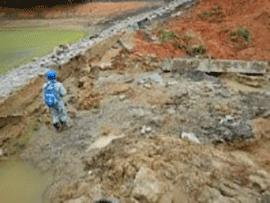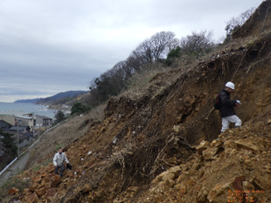In the Regional Disaster Prevention Group, we evaluate the risk of damage caused by debris flow into irrigation ponds during heavy rains, develop methods for estimating potential inundation areas in the event of an irrigation pond collapse, stability evaluation method for agricultural landslides and methods for enhancing the flood control functions of irrigation ponds.
There are about 160,000 irrigation ponds in Japan, many of which were not used modern civil engineering technology but built using empirical techniques in the old days. Since many of irrigation ponds are vulnerable to torrential rains and earthquakes, it is necessary to improve them to withstand torrential rains and earthquakes and take evacuation measures in case of a collapse. While irrigation ponds are used to store water for agriculture, they also function to temporarily store floodwater during heavy rains and prevent downstream flooding. By strengthening this function, irrigation ponds are expected to prevent flooding of farmland downstream and contribute to river flood control. In farmlands and rural villages in hilly and mountainous areas, there are many landslide sites. Hence at the event of earthquakes, heavy rain, and melting of snow, landslide disasters occur repeatedly. Landslide site management methods are especially needed in the rural areas, where the aging population and population decline is progressing.
To develop relevant technologies to above issues, we are conducting field observations and model tests to clarify phenomena related to the inflow of floods and debris flow into irrigation ponds as well as those related to flooding at the time of irrigation pond collapse. We are also developing simulation methods to reproduce and evaluate such phenomena and methods to determine flooded areas while creating hazard maps and simple techniques to calculate the amount of landslide movement.


Members
- KUSUMOTO Takeshi (Leader)
- INOUE Keisuke(Deputy Leader)
- HIROSE Yuichi
- SHODA Daisuke
- LEE Sangyoon
- KOJIMA Hajime
- JIKEYA Yuki
- YOSHIZAWA Masayoshi




